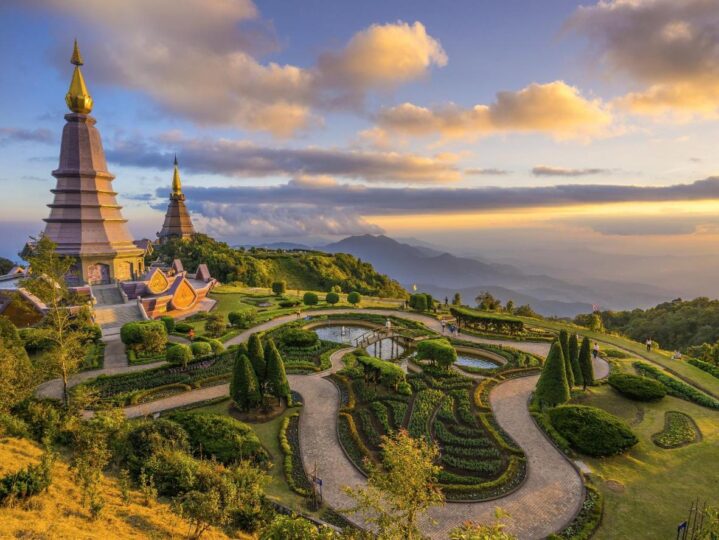
Magnificent jewel of the North: Chiang Mai
Chiang Mai (sometimes spelled Chiengmei or Chiangmai) has more than enough charm to spare for all – for residents and visitors alike. It is well known for its cool winter climate, lush foliage, roses and other colourful flora, native handicrafts, and fascinating scenery. It has earned its reputation as one of Thailand’s most favourite tourist attractions.
The capital of Chiang Mai province, the city is about 685km (or 425 mi) north of Bangkok. Situated close to the country’s highest mountains, it boasts spectacular panoramic backdrops. These impressive peaks include Doi Suthep and Doi Inthanon, the tallest mountain in Thailand. Chiang Mai occupies a strategic position along the Ping River, a major tributary of the Chao Phaya. The city has long been a regional trade crossroads for centuries. Its key location has contributed to the city’s historic importance. The whole metropolitan area counts about one million people, Thailand’s second largest city. The name Chiang Mai means ‘New City’ in Thai.
The city was founded in either 1294 or 1296 by King Mangrai as the new capital of the Lanna Kingdom. According to local historic lore, the city was built on the site of an older site that was populated by the Lawa ethnic group. Thai historians now accept that Chiang Mai was built as a Northern fort city to potentially stop the Southern invasion from the Mongols in the 13th century. Old period Chinese garrison towns inspired the city’s square moat design. The outlying sophisticated irrigation system has many of the hallmarks of old Khmer Empire irrigation construction techniques. On its foundation, Chiang Mai succeeded Chiang Rai, the old Lanna Kingdom capital.
Like much of early Thailand history, Chiang Mai’s story is shrouded in legend due to the lack of surviving written records. Since all buildings were constructed of wood, little remains of old structures in a tropical climate. So archaeologists have had to rely on coins, pot shards, and datable ceramics plus the annals of the surrounding civilisations in Burma, China, Laos and Cambodia for information or clues.
King Pha Yu (reigned 1337-1355) enlarged and fortified the city. There was a defensive moat and brick wall built to surround the city against their closest enemies, the Taungoo Kingdom, a large Burmese based empire. Some of these defensive structures are still in existence. As the Lanna Kingdom declined in importance, the Taungoo troops occupied the city in 1556. In 1599, the Lanna Kingdom lost its independence and became part of the Ayutthaya Kingdom until it was overthrown in 1767 by Burmese invaders. Later the Lanna Kingdom became part of the Thonburi Kingdom under King Taksin when the Burmese were finally expelled from the Northern part of Thailand. But even under the succeeding Chakri Dynasty the Siamese government only held nominal control of the Northern part of the country, at best, due to the distance involved, lack of effective communications and many other problems the government had to attend to in Bangkok.
Chiang Mai remained a modest, if serene, outpost until late in the 19th century until the city’s fortunes underwent a sudden spectacular economic expansion. Untold wealth started to pour into the city’s coffers from the British government who wanted teak to form ship masts. Two British companies, the Bombay Burmah Trading Corporation and the Borneo Company Limited, received concessions from the Thai government to harvest teak starting in the late 1880s and early 1890s. Soon huge teak logs were being floated down the Chao Phraya River to various lumber yards and mills in Bangkok to be processed for export. In short order, other Thai and Chinese firms quickly entered the business and the country’s Northern forests started to be rapidly decimated.
Eventually the Lanna Kingdom was formally merged into the Siamese Kingdom in 1893. For centuries it took about three weeks to reach Chiang Mai from Bangkok. That situation completely changed when a railroad line was built in 1912 between the two cities. By 1922 the first roads were constructed, and the city started to see growth and increased prosperity. With the rise in international tourism, Chiang Mai’s many attributes and attractions have acted as a magnet for ever growing groups of tourists who want to experience the city’s many benefits. Chiang Mai remains, literally, an important crown jewel of Thailand’s wealth.


